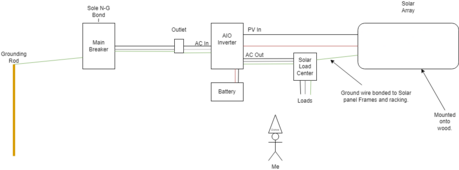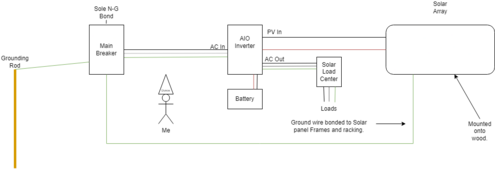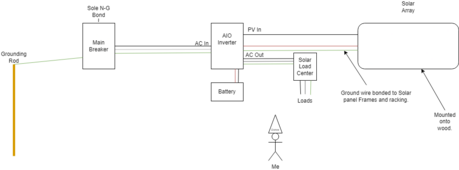I've been doing a lot of reading and watching on this subject, including reading Filterguy's "Grounding Made Simpler", but despite that there's still a lot that I don't understand, and I'm probably going to use incorrect terminology, so forgive me in advance. Me am dumb.
I intend to build a small solar setup, but I'm debating on whether to connect it to the existing system, or whether to have it stay completely separate.
In particular I'm trying to understand how to ground the system properly. I'm wondering if I can use the 'AC In' of an AIO inverter to connect my loads, AND my solar panel frames/racking to true earth ground. Something like this:

There's a few things I'm unsure of though.
1: Is the 'AC In' of an AIO inverter always active? I'm not sure if it might disconnect when it's not charging for example.
2: Is it fine to have my panel frames attached to ground through all of my equipment? Even mounted on wood it's going to be sort of a grounding rod itself no?
Is it fine to allow any static build-up to discharge through my equipment like that?
3: I'd assume a nearby lightning strike would be really bad with this setup. If I attach a MidNite surge protector, would that be effective mitigation? Would I have to do that on both sides of the system?
And please point out anything I'm missing, I'm sure there is plenty.
I intend to build a small solar setup, but I'm debating on whether to connect it to the existing system, or whether to have it stay completely separate.
In particular I'm trying to understand how to ground the system properly. I'm wondering if I can use the 'AC In' of an AIO inverter to connect my loads, AND my solar panel frames/racking to true earth ground. Something like this:

There's a few things I'm unsure of though.
1: Is the 'AC In' of an AIO inverter always active? I'm not sure if it might disconnect when it's not charging for example.
2: Is it fine to have my panel frames attached to ground through all of my equipment? Even mounted on wood it's going to be sort of a grounding rod itself no?
Is it fine to allow any static build-up to discharge through my equipment like that?
3: I'd assume a nearby lightning strike would be really bad with this setup. If I attach a MidNite surge protector, would that be effective mitigation? Would I have to do that on both sides of the system?
And please point out anything I'm missing, I'm sure there is plenty.




